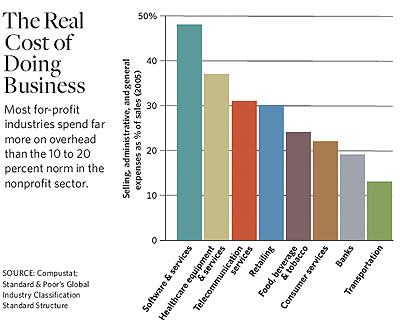October
2009
October 7, 2009
Nonprofits Are Getting Caught in a Starvation Cycle
In both the public and private sectors, organizations that build robust infrastructures are more likely to succeed than those that do not. Despite this general rule, nonprofits perpetually spend very little on information technology systems, financial systems, skills training, fundraising or other types of essential overhead. In a recent survey by the Bridgespan Group of 100 nonprofits across the country, 56% planned to cut overhead even further in an attempt to weather the current recession. Doing so may jeopardize the organizations’ very existence, not to mention their ability to accomplish their missions.
If meager infrastructures are so detrimental to organizations, why then is this a continuing trend within nonprofits? Further research by Bridgespan reveals a three-part cycle that contributes to the persistent underfunding of overhead:
- Funders’ expectations of how much it costs to run a nonprofit are unrealistic.
- Nonprofits feel pressure to conform to these expectations.
- Nonprofits respond by spending too little on overhead as well as underreporting their expenditures on tax forms and in fundraising materials. The underfunding and underreporting done by organizations in turn perpetuates unrealistic expectations and the cycle repeats itself. Over time, funders come to expect grantees to do more and more with less and less � a cycle that inevitably starves nonprofits.
Many funders do realize that nonprofits report artificially low overhead figures. However, without accurate data it is difficult to determine what appropriate figures should be. Although spending between 10% and 20% of operating expenses on overhead is commonly accepted in the nonprofit sector, other industries spend a considerably larger share (see figure below). Understanding real overhead costs and infrastructure needs takes commitment from both funders and grantees.

For more information, read the Stanford Social Innovation Review‘s The Nonprofit Starvation Cycle.
If you would like to talk to a NASAA staff person about the information in this column, contact Shannah Sphar
In this Issue
State to State
- Texas: Tourism Development Workshops
- Mississippi: Museum on Wheels
- Washington: Surveys and Webinar
- Rhode Island: Design Innovation Grant
- Virginia: Cultural Tourism Partnership Grants
Legislative Update
Executive Director's Column
Research on Demand
Did You Know?
SubscribeSubscribe
×
To receive information regarding updates to our newslettter. Please fill out the form below.
